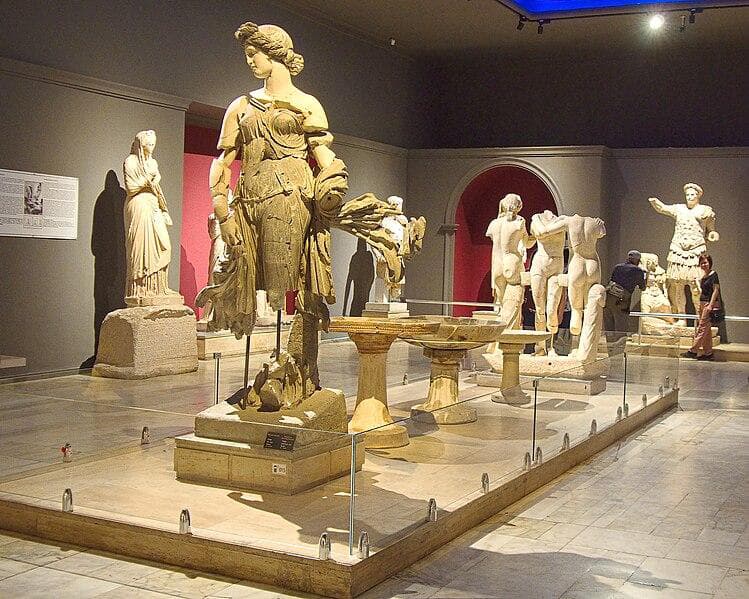Antalya, a city rich in history and culture, offers a wealth of museums and galleries that showcase its diverse heritage.One of the most notable is the Antalya Museum, also known as the Antalya Archaeological Museum (Turkish: Antalya Müzesi), is one of Turkey’s largest museums, located in Muratpaşa, Antalya. It includes 13 exhibition halls and an open-air gallery, covering an area of 7,000 m2 (75,000 sq ft).
The museum displays around 5,000 works of art, with an additional 25,000–30,000 artifacts in storage. As a museum showcasing the history of the Mediterranean and Pamphylia regions in Anatolia, it is one of the most important museums in Turkey. The museum was awarded the “European Council Special Prize” in 1988.
History of the Museum
The museum’s origins date back to the end of World War I when Antalya was under Italian military occupation. Italian archaeologists began removing archaeological treasures from the city center and its surroundings, claiming to do so in the name of civilization.
To prevent these initiatives, Süleyman Fikri Bey, the Sultan’s advisor, applied to the Antalya post of provincial governor in 1919. He appointed himself as the voluntary curator of antiquities and established the Antalya Museum to collect and preserve the remaining artifacts.
Initially, the museum operated in the Alâeddin Mosque in 1922. From 1937 to 1972, it was housed in the Yivli Minare Mosque before moving to its current building.
The museum underwent significant modifications and restorations in 1982 and was reopened to the public in April 1985, following modern museum concepts implemented by the General Directorate of Ancient Objects and Museums.
Exhibition Halls
The Antalya Museum consists of 13 exhibition rooms, an open-air exhibition area, laboratories, a storeroom, repair shops, a photographic room, a conference hall, administrative offices, a cafeteria, and living quarters for museum officials. The exhibition rooms include:
- Natural History Hall: Showcases living creatures from humans to single-celled animals, charts, pictures, fossils, and bones.
- Pre-History Hall: Exhibits artifacts from Karain, Öküzini, and Sehahöyük, ranging from the Paleolithic to the Roman Age, including animal fossils and kitchen utensils.
- Proto-History Hall: Features artifacts from the Neolithic, Chalcolithic, and Early Bronze Age found in Hacılar, with most items from Semahöyük and its surroundings.
- Classic Period Hall: Displays works from the Mycenaean to the Hellenistic Age, including earthenware figurines, wine bowls, dishes, and a statuette of Apollo. Roman period statuary also makes up a significant portion.
- Statuary Hall: Exhibits statues of mythological figures from the 2nd and 3rd centuries AD, found in Perge, including Minerva, Zeus, Artemis, and others.
- Hall of Imperial Statues: Features statues of emperors, empresses, and other Roman period figures, including Plancia Magna, Emperor Hadrian, and Emperor Septimius Severus.
- Sarcophagus Hall: Displays Roman period sarcophagi from Pamphylia and Sidemara, with notable pieces like the Domitias sarcophagus and the Twelve Labours of Hercules.
- The Mosaic Hall: Exhibits Byzantine period mosaics from Ksantos and icons from the Antalya region.
- Hall of Church Artefacts: Showcases wooden church illuminations depicting the life of Jesus Christ and artifacts related to Saint Nicholas.
- Hall of Small Objects: Features lamps, glass objects, a gold inlay silver tray, incense holders, and lintel figures from a tomb found opposite Lymira.
- Hall of Coins: Displays coins from the Hellenistic to Ottoman periods, including city and imperial coins.
- Turkish – Islamic Period Works: Contains Seljuk and Ottoman tiles, Anatolian carpets, inscriptions, books, candlesticks, lamps, and dervish paraphernalia.
- Ethnographic Hall: Exhibits clothes, embroidery, weapons, and metal objects from the Antalya region, with a corner furnished as a typical Anatolian house.
Another significant site is the Antalya Atatürk House and Museum, located in the Muratpaşa district. This two-story house is where Mustafa Kemal Atatürk, the founder of the Turkish Republic, stayed during his visit to Antalya in 1930.
The house has been converted into a museum, preserving Atatürk’s legacy and providing insights into his life and contributions. Visitors can explore the personal belongings and memorabilia of Atatürk, offering a unique glimpse into the life of one of Turkey’s most revered figures.
For those interested in the history of toys, the Antalya Toy Museum is a unique and delightful experience. Managed by the Antalya Metropolitan Municipality, this museum showcases a wide range of toys from different eras, offering a nostalgic journey for visitors of all ages. The collection includes toys from various cultures and time periods, highlighting the evolution of play and entertainment through the ages.
Beyond museums, Antalya’s natural beauty is also a major attraction. Kabak Beach, with its stunning landscapes and clear waters, is a popular destination for both locals and tourists. It provides a perfect blend of cultural exploration and natural relaxation. The beach is surrounded by lush greenery and offers a serene escape from the bustling city life.
In conclusion, Antalya’s museums and galleries offer a comprehensive look into the region’s rich history and cultural heritage.
Whether you’re interested in archaeology, history, or art, Antalya has something to offer every visitor. The city’s blend of historical sites and natural wonders makes it an ideal destination for those seeking a well-rounded travel experience.
